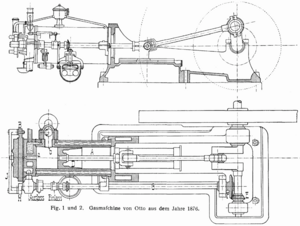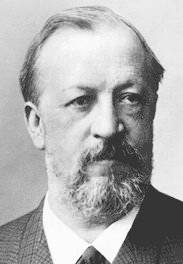Niklaus Otto facts for kids
Nikolaus August Otto (June 14, 1832 - January 28, 1891) was a clever German engineer. He is famous for inventing the internal-combustion engine. This amazing invention changed how machines work! Before Otto's engine, most engines burned fuel outside, like old steam engines. But Otto's engine burned fuel right inside the engine's main part, making it much more powerful and useful.
Contents
Nikolaus Otto: The Engine Inventor
Nikolaus August Otto was born in Holzhausen an der Haide, Germany, on June 14, 1832. He didn't start as an engineer. Instead, he worked in business, selling groceries and even working as a traveling salesman. But he was always interested in new ideas and machines.
Early Life and Big Ideas
Even without formal engineering training, Otto was very curious about technology. He became fascinated by the idea of an engine that could run on gas. In the 1860s, he started experimenting with different engine designs. He wanted to create an engine that was more efficient and practical than the steam engines used at the time.
The First Steps in Engine Design
Otto's first attempts were with a gas engine designed by a French inventor named Étienne Lenoir. Lenoir's engine was the first to use gas as fuel. However, it wasn't very powerful or efficient. Otto saw ways to make it much better. He believed he could create an engine that used fuel more wisely.
How Otto's Engine Changed Things
Otto's biggest breakthrough came in 1876. He developed what is known as the "Otto cycle" engine. This was the first successful engine that burned fuel directly inside its main chamber, called a cylinder. This is why it's called an internal-combustion engine.
Internal vs. External Combustion
- External-combustion engines: Think of old steam engines. They burn fuel (like coal or wood) in a separate furnace. This heat then boils water to create steam, which pushes a piston. It's like heating a kettle on a stove.
- Internal-combustion engines: Otto's engine burns the fuel (like gas) right inside the engine's cylinder. This creates a small explosion that directly pushes a piston. It's much more direct and efficient.
The Four-Stroke Cycle
The key to Otto's engine was its "four-stroke cycle." This is a series of four steps that the engine's piston takes to create power:
- 1. Intake stroke: The piston moves down, pulling a mix of fuel and air into the cylinder.
- 2. Compression stroke: The piston moves up, squeezing the fuel and air mixture. This makes it very powerful.
- 3. Power stroke: A spark ignites the squeezed mixture, causing a small explosion. This pushes the piston down with great force, creating power.
- 4. Exhaust stroke: The piston moves up again, pushing out the burnt gases through an exhaust valve.
This four-stroke process made Otto's engine much smoother and more powerful than earlier designs.
Otto's Legacy
Nikolaus Otto's invention was a huge step forward for technology. His four-stroke internal-combustion engine became the basis for almost all modern engines. This includes the engines in cars, motorcycles, and many other machines we use every day.
Otto's work helped kick off the age of the automobile and changed how people traveled and transported goods. He died on January 28, 1891, but his legacy lives on in every engine that uses his brilliant design.



